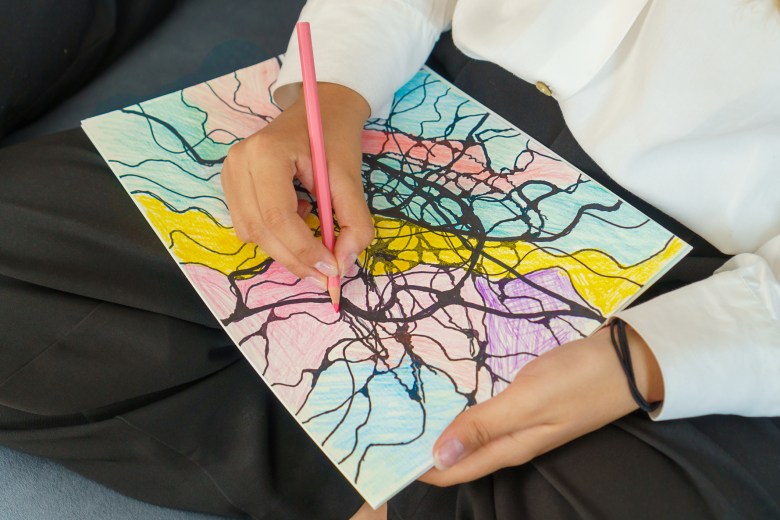 Getty Images
Getty Images
When San Jose State University student Kenneth speaks of putting on white noise to calm his thoughts or opening his Notes app to sort through emotional clutter, he is doing more than coping.
He is engaging in an act of therapy, calming internal chaos into external order.
His habits mirror habits of many students who use music, journaling, or visual art to manage stress, anxiety, or heartbreak. Therapists have consequently taken inspiration from these habits, incorporating art into their professional care plans. Creative expressions like art and music therapy are increasingly stepping into the spotlight in addiction recovery, offering new pathways toward healing and self-understanding.
In residential rehab center Homewoods Ravenview, music therapist Kirsten Davis recalls working with a patient who hadn’t touched a piano for years due to trauma. The patient initially avoided all musical activity but slowly began playing during music therapy sessions. Over time, they started using the piano to express their fears, regrets, and hopes.
“It was through that piano voice that they found words,’” Davis says. “By the end, they were able to communicate feelings they couldn’t before.”
The music helped the patient connect with their own emotions and engage with the therapy program, proving how creative expression can help with addiction recovery
Michelle Guinness, the lead arts therapist in an addiction and mental-health program in the UK, explains in an interview with the Society for the Study of Addiction that creative work acts as an emotional safe landing. She says, “When a client presents an image…they offer a view of themselves, of their internal world which can be full of symbols and metaphors. Verbalising thoughts, feelings and emotions may sometimes be difficult, and this is where art therapy is an ideal medium.”
Guinness is an example of one of the many rehab workers who have personally experienced how clients who fail to express themselves with words find a way to open up through artistic measures.
These stories are part of a larger pattern supported by broad evidence. Over the past decade, research into music therapy and art in drug treatment has grown. A systematic review published in Cochrane examined 21 studies with nearly 2,000 participants and found that music-based interventions may reduce anxiety and depression, enhance engagement with treatment, and improve emotional regulation. A PLOS review that examined 34 data-based studies and 6 interview based-studies found that although results are not certain, many programs showed short-term improvements in mood, coping skills, and craving management.
Recent research has shown how creative activities can affect brain function. In music therapy, listening to music and making music has shown to trigger the same brain pathways as certain drugs, which may help reduce cravings and stress during withdrawal. A 2023 biomedcentral study published in “Addiction Science & Clinical Practice” found that music therapy has the ability to lower cravings, improve mood, and strengthen self-control, even though more research is needed.
However, the research still has its limits. An article published on PLOS concluded that most of the studies are small, short, and lack strong comparison groups, so it’s hard to know if creativity alone causes improvements. According to Health Systems Research, some reviews say there’s no clear proof that it helps people maintain long-term soberness. Recovery Village says that in practice, creativity is rarely a stand-alone cure. Instead, it is used as an aid in a larger treatment plan that includes therapy, medicine, support groups, and behavior programs.
One of the largest challenges to expanding music therapy is access. Small and rural rehab centers cannot afford or access trained art or music therapists. Insurance doesn’t clearly cover these kinds of therapies. Because creative therapy is seen as an add-on instead of the main treatment, it is one of the first services removed when money is tight.
Additionally, the American Music Therapy Association has described how creative therapies can be triggering as music and imagery can remind patients of negative memories in Post-Traumatic Stress Disorder (PTSD) or past trauma. Therapists must research a person’s background and be prepared for emotional flooding.
Music and art therapy aren’t just used in addiction centers. In schools, it helps students express their feelings and improve mental health. Community centers in Oakland and Richmond offer art and music programs for teens who may be at risk for drug abuse. Prisons have also begun using these therapies.
Notably, Scotland’s Joyce Laing worked with incarcerated individuals, believing that “if you can channel that energy into positive creation instead of destructive creation, then you’re on to a winner.” Policymakers in several states are testing programs to bring creative therapy into public health and youth justice systems.
When I circle back to Kenneth, I see the same impulse. When his mind feels chaotic, art and sound are his way of turning his thoughts into something he can see and hear. It helps his emotions breathe and calm down.
For victims of substance use, the impulse to relax their feelings acts as a medicine to their addictions. The goal for the future is to have treatment centers humming with strings, brushes, and soft rhythms.
Clinics where people can paint next to inspiring posters, where gentle harp music plays during group sessions, and where clients learn not only to resist a drug but to find their voice through color or melody.
Art therapist Cathy Malchiodi claims that “Expressive arts therapy … is a non-verbal way of self-expression of feelings and perceptions … they tap implicit, embodied experiences of trauma that can defy expression through verbal therapy.”
One day, perhaps a person in recovery will not only say, “I found my life again,” but “I composed it, I painted it, I sang it.”
This article was written as part of a program to educate youth and others about Alameda County’s opioid crisis, prevention and treatment options. The program is funded by the Alameda County Behavioral Health Department and the grant is administered by Three Valleys Community Foundation.
Most Popular
